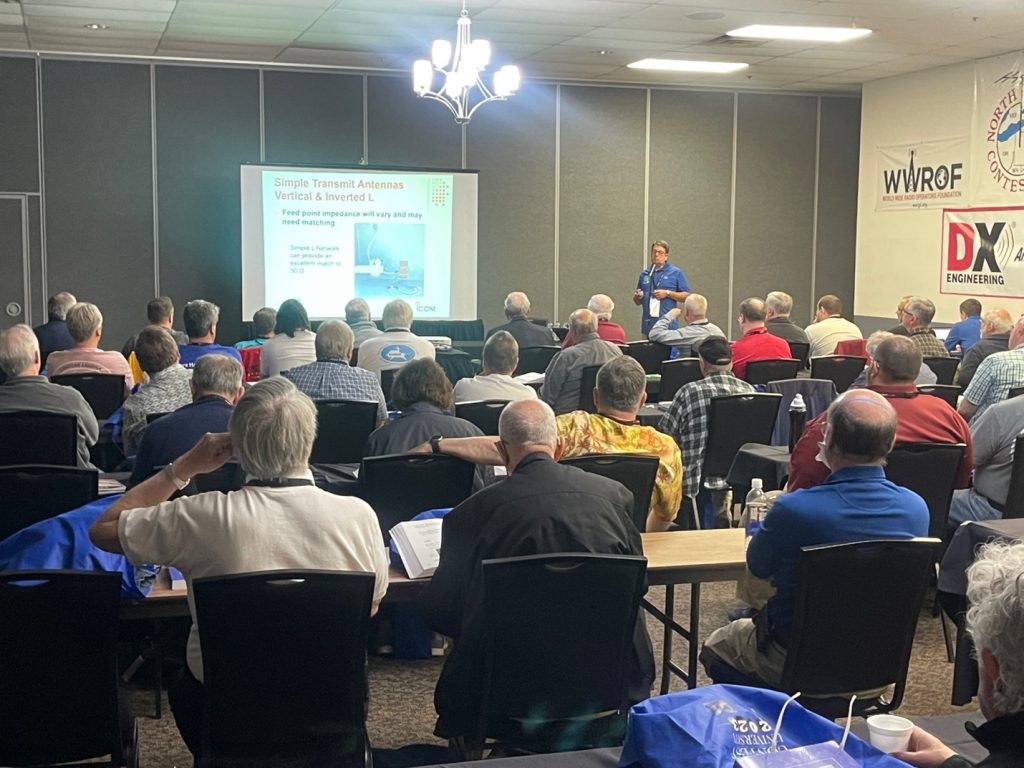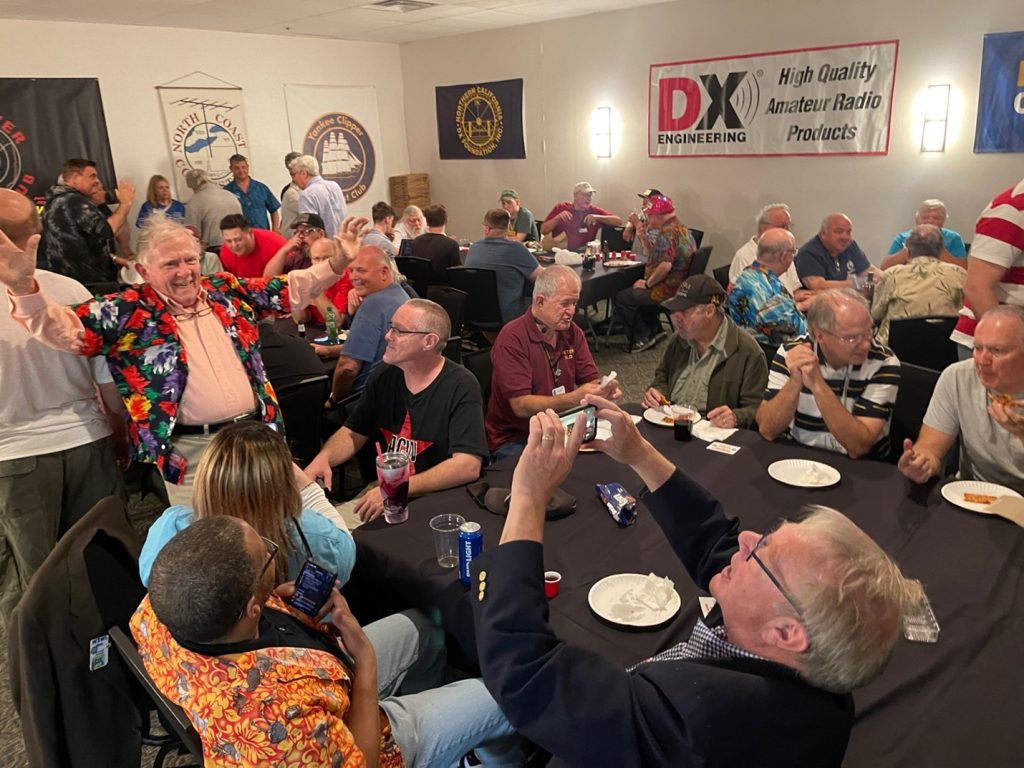Contest University Only Five Months Away—Register Today!
We begin the year’s first ham radio contest guide with exciting news: Registration for Contest University 2024 is officially open. The 15th year of this popular educational seminar for contesters will take place one day before Dayton Hamvention® on Thursday, May 16, at the Hope Hotel on Wright-Patterson Air Force Base, ab0ut 35 minutes from Xenia, Ohio. The event promises to be better than ever. A list of Contest University presenters and their topics will be posted soon. Visit the Contest University website for much more information and to register. Here are a couple of photos from last year’s event:

(Image/OnAllBands – Katie Rockman)

(Image/OnAllBands – Katie Rockman)
Make this the Year of Young Operators!
As we kick off the 2024 amateur radio contesting year, OnAllBands would like to draw your attention to one particular event: ARRL Kids Day on January 6. It’s a great chance to begin the year by making it a priority to nurture future generations of ham radio operators. In addition to participating in this biannual event, here are a few other ways to make an impact:
- Volunteer to speak in science classrooms about amateur radio
- Donate equipment to help build school stations and volunteer your technical expertise
- Get involved in scouting’s Jamboree On The Air, October 19, 2024
- Organize events like fox hunts at Field Day to get young people excited about ham radio
- Donate the easy-to-build DX Engineering Single-Band Low-Power Dipole Kits to youth groups. The kits, which include a center insulator, two end insulators, and a right-angle BNC connector, make a practical group project or a fun one-on-one opportunity to teach rudimentary soldering and amateur radio antenna basics.
Speaking of young people, OnAllBands and DX Engineering would like to give a big shout out to students from Harbor Creek School in Harborcreek, Pennsylvania, who spoke with European Space Agency astronaut Andreas Mogensen, KG5GCZ, on the International Space Station (ISS) the morning of December 11. The well-attended event was a huge success, drawing waves of positive attention to the learning opportunities afforded by amateur radio. After the 10-minute contact with the commander of the ISS, students displayed work they had been doing on SDRs, radio astronomy, fox hunting, high-altitude ballooning, and other topics. Overall, it was a monumental day for amateur radio. We salute the student participants and everyone who made it possible!
What’s Up in January?
Marconi Club ARI Loano QSO Party Day, January 6, 0700Z to 2100Z. Founded in 1988 by Libero, I1YXN, and Baldur, DJ6SI, the Marconi Club ARI (Associazione Radioamatori Italiani) Loano is a group of more than 940 operators worldwide who are devoted to the art and science of making contacts through CW. The club’s first president was Guglielmo Marconi’s wife, Maria Cristina Marconi, who passed away in 1994 at the age of 94. The club’s current president is Marconi’s 93-year-old daughter Princess Elettra Marconi Giovanelli. This marks the sixth edition of the club’s QSO party. For this year’s 80/40/20M CW event, the prize for first place will be a Begali key donated by the famous Italian company. Find complete QSO Party rules here. And learn much more about the Marconi Club ARI Loano at its official website.
ARRL Kids Day, January 6, 1800Z to 2359Z. As noted above, here’s a win-win opportunity to introduce ham radio to your children, grandchildren, nieces, nephews, and their friends. You benefit by creating memories, and they benefit by learning about the magic of transmitting and receiving messages via amateur radio. It’s precious time together that everyone will remember forever. For Scouting and other groups, it can also make a unique and meaningful get-together.
EUCW 160M Contest, January 6, 2000Z to 2300Z, and January 7, 0400Z to 0700Z. This annual contest is run by the European CW Association—an organization that hosts European CW clubs. As an exchange forum, the EUCW’s objective is to “form an association of independent European amateur radio CW clubs. Using the association as a platform, member clubs may exchange ideas and information, arrange various activities involving mutual participation, and generally cooperate for the benefit of amateur radio CW operation,” per the EUCW website. Learn more about the organization here.
ARRL RTTY Roundup, January 6, 1800Z to January 7, 2400Z. Amateurs worldwide contact and exchange QSO information with other amateurs using RTTY on 80, 40, 20, 15, and 10 meters. Any station may work any other station. Stations may be worked once per band, regardless of mode. Automated operation is not permitted; each claimed contact must include contemporaneous direct initiation by the operator on both sides of the contact.
YB DX Contest, January 13, 0000Z to 2359Z. This SSB contest is hosted by the YB Land (Indonesia) DX Club and is open to amateurs around the world.
North American QSO Party, CW, January 13, 1800Z to January 14, 0559Z. From the National Contest Journal: “The North American QSO Parties are favorites of beginners and seasoned operators alike. The NAQPs are low-power only (no amplifiers allowed) which makes for a lot more breathing room on the bands. Small stations can generate very effective ‘runs’ in the NAQP contests. Multipliers count once per band, which makes for an exciting format, as multipliers can be ‘moved’ from band to band. The NAQPs allow stations from all parts of North America to be in the running for the top spots.”
CW not your thing? The SSB portion of the contest runs January 20-21, 1800Z to 0559Z. The North American Collegiate Championship, SSB, is scheduled to run simultaneously with the North American QSO Party. Read more about this annual event here.
Hungarian DX Contest, January 20, 1200Z to January 21, 1159Z. This SSB and CW event is open to licensed operators around the world. For this year, a special youth-only single-operator mixed mode category (age 25 and younger) has been added. Find all the rules here.
ARRL January VHF Contest, January 20, 1900Z to January 22, 0359Z. For amateurs in the U.S. and Canada (and their possessions) to work as many amateur stations in as many different 2 degrees x 1 degree Maidenhead grid squares as possible using authorized frequencies above 50 MHz.
Australia Day Contest, January 25, 2200Z to January 26, 1000Z. Hosted by the Wireless Institute of Australia, this event is held annually on Australia Day (January 26), the country’s official national day which marks the 1788 landing of the First Fleet at Sydney Cove and the raising of the Union Flag. Records of celebrations on January 26 date back to 1808.
Per the contest’s website, “Amateurs in VK will endeavor to contact other amateurs around the world. Some VK operators will be using the AX prefix to celebrate Australia Day, as it’s wanted by many amateurs around the world.
Scoring is distance based and calculated using 4-character grid squares.”
If you’re looking to boost your station’s capabilities, we recommend the Australian-made Monitor Sensors Power and SWR Meter—an innovative, compact, well-built, and powerful device that complements both high-powered stations and portable QRP setups. It features frequency coverage from 130 kHz to 30 MHz and a power range from 10mW to 2,000W. One customer noted, “Not only does it provide an excellent readout of power, but the Alarm contact is a great way to protect your amp from damage in the event of high SWR.”
CQ 160 Meter Contest, CW, January 26, 2200Z to January 28, 2200Z. For amateurs around the world to contact other amateurs in as many U.S. states, Canadian provinces, and countries as possible utilizing the 160-meter band.
You’ll find plenty of help for your 160-meter pursuits at DX Engineering: vertical antennas, add-on kits (including the new kit to add 160M to your Butternut antenna), matching networks, DXing on the Edge, the Thrill of 160 Meters by Jeff Briggs, K1ZM, and more.
Winter Field Day, January 27, 1900Z to January 28, 1900Z. The first Winter Field Day was held the weekend of January 13-14, 2007. Since then, thousands of participants have bundled up and schlepped their gear into the cold to practice portable emergency communications in winter environments. If you truly want to be prepared for the worst, you should too.

